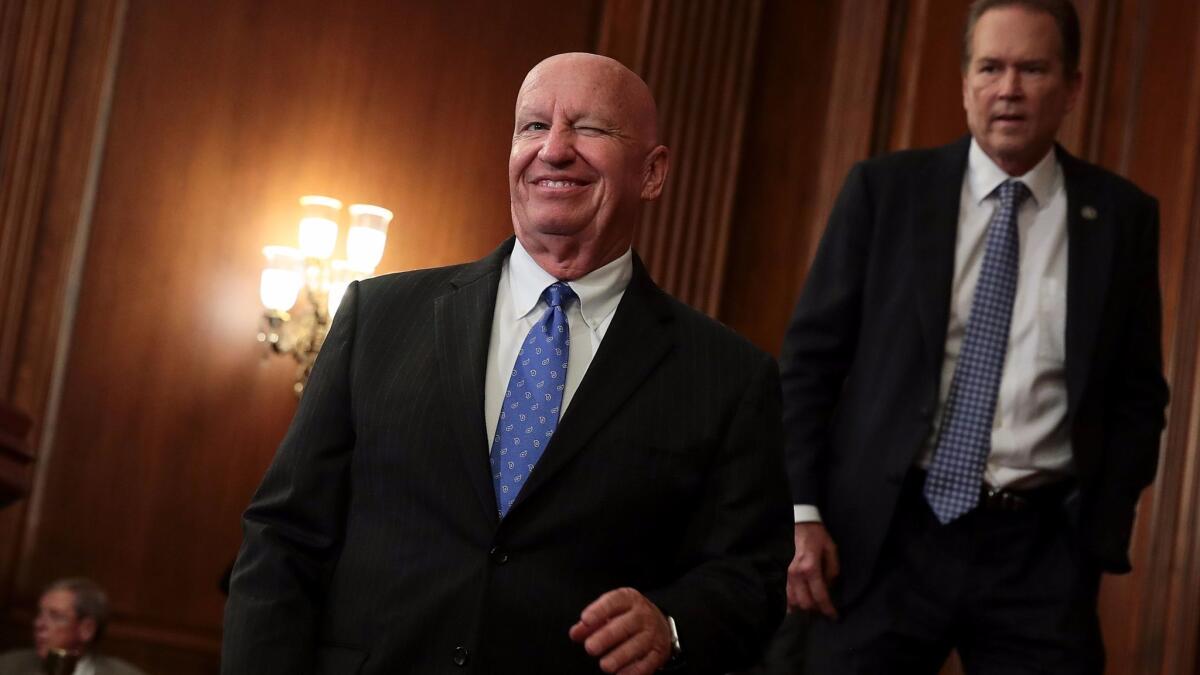Column: Republicans want to slash tax deductions for your 401(k). That’s actually a good idea!

- Share via
When word leaked out a few weeks ago that House Republicans were thinking of drastically slashing the tax deduction for 401(k) contributions, retirement experts, Wall Street bankers and Democrats joined together to sound the alarm.
To them, this reeked of denying the ordinary retirement saver a tax break in order to deliver a big tax cut for the rich. Asset managers predicted a sharp drop in 401(k) balances for workers whose annual contributions went from tax-free to taxable, and therefore became more expensive. The cut in deductibility looked enormous, reducing the maximum tax-advantaged contribution to as little as $2,400 a year from the current $18,000 (or $24,000 for workers over 50).
As it turns out, however, this may be the rare idea from the GOP caucus that could help the middle class. The tax deductibility of 401(k) contributions actually may be leaving people with less money in retirement, not more. Most people don’t understand that, in part because it’s not especially well-understood by Wall Street asset managers. As a result, they can make the wrong choices in planning for their retirement.
The Roth fund is worth more because every single dollar in the account can be withdrawn tax-free.
— John Beshears explains why tax-deductible 401(k) plans are not as good as they look
We’ll explain why in a moment. But first, we’ll conjecture that the drafters of the tax proposals in the House Ways and Means Committee, which is expected to produce a formal tax plan next month, don’t have the welfare of middle- and working-class workers foremost among their concerns. The idea seems rooted more in their need to raise tax revenue now to fund a tax cut going forward. Tax deductions for 401(k) contributions cost the Treasury about $115 billion a year.
That wouldn’t put much of a dent in the $1.5-trillion in budget savings the Republicans are shooting for, but a few such dents put together could get them closer to their goal. And although Republican tax “reform” isn’t always aimed at helping the rich at the expense of everyone else, that’s the way to bet.
The political consequences even of an apparent cut to 401(k) benefits are well understood by Democrats, who have jumped on the bandwagon attacking the Republican plan, and President Trump, who tweeted early Monday that there will be “NO change to your 401(k).” He called it “a middle class tax break that works.”
How well it “works,” however, is open to question.
The reasons are buried in the peculiarities of tax-advantaged retirement plans. The rules are similar for 401(k)-type defined contribution plans, which are offered by employers that often match a portion of their workers’ contributions, and Individual Retirement Accounts, or IRAs, which are for the self-employed or those whose employers don’t offer pensions.
Contributions to such plans come out of pre-tax income, so they’re effectively tax-deductible. A worker earning, say, $80,000, paying a marginal federal tax rate of 25% and putting $5,000 into a 401(k) account or IRA would have only $75,000 in taxable income, cutting his or her tax bill by $1,250. That would reduce the real cost of the contribution to only $3,750. The catch is that the principal and investment income of that account is fully taxable when it’s withdrawn in retirement.
In 1997, Congress gave retirement savers an alternative by creating the Roth IRA. Contributions to these accounts aren’t deductible from current income when they’re made, but the contributions and investment gains are tax-exempt when they’re withdrawn. Congress introduced Roth 401(k) plans, which operate on the same principle, in 2006, though it’s up to employers to choose whether to offer the option to their workers.
Traditionally, the rule of thumb on IRAs and 401(k) plans has been that if you expect your tax rate to be lower in retirement than during your working years, take the deduction now and pay the taxes later. Since most people expect their income, and thus their tax rate, to fall after they retire, this option has helped Americans accumulate private nest eggs totaling about $16 trillion in IRA and 401(k) accounts.
But the rule of thumb is wrong, or at least extremely misleading. Many, even most, people may actually end up with more money to spend in retirement if they go the Roth route of deferring their tax exemption into the future.
The reasons are complicated and the results are dependent on individuals’ tax situations as well as the growth rate of their retirement accounts. But they boil down to the fact that the future tax exemption, even for those with a lower tax rate in retirement, gets applied to a much larger sum than the current-year deduction.
“The Roth fund is worth more because every single dollar in the account can be withdrawn tax-free,” John Beshears of Harvard, the co-author of a 2015 study of contribution habits, told the Wall Street Journal in an interview earlier this year.
The example he gave was of a worker saving $5,000 a year in a 401(k) for 40 years, earning an average annual return of 5%. That would produce a final balance of more than $600,000. “If the 401(k) is a Roth, the full balance is available for retirement spending.” If it’s a traditional 401(k) and the owner’s tax rate in retirement is 20%, “that makes for a difference of $120,000 in spending power, which a life annuity will translate into about $700 a month in extra spending.”
One additional point is that distributions from a Roth plan don’t count as income when figuring whether a retiree’s Social Security benefits are taxable, but distributions from a traditional plan do count. That means that higher Roth balances could reduce a retiree’s other taxes.
The superiority of Roth savings over traditional accounts seems to apply across the income spectrum, regardless of any significant differential between workers’ current tax rates and the lower rates in retirement. For most people, the only way to end up with more in retirement under the traditional deduct-now-pay-later system is to reinvest one’s tax savings every year and hold them for the future. For some workers, the combined IRA or 401(k) balance, plus the invested tax break, will yield more in retirement than the Roth system. In other words, our $80,000 worker above should place his or her $1,250 tax break in a separate account and allow it to grow over time, then combine it with his or her IRA or 401(k) balance in retirement.
But how many people actually do that? Beshears thinks the answer is: “No one.” The reason is that people follow the rule of thumb of maximizing their IRA or 401(k) contributions, and don’t adjust their set-asides based on the tax implications now or in the future. His 2015 study found that there was no difference in worker contribution rates whether their employers offered a Roth 401(k) or not. Beshears and his co-authors weren’t sure why that would be, but they did find “evidence of employee confusion about and neglect of the tax properties of before-tax and Roth accounts.”
It’s more likely than not that most investors in traditional IRA or 401(k) plans use their tax deductions for current expenses in the year the contributions are made — how many people sock away a larger-than-expected tax refund for the future, instead of spending it? The numbers suggest that they’re shortchanging themselves.
A couple of handy calculators for how all these options work can be found here and here. The first limits inputs for the maximum IRA contribution, but the principle is the same for 401(k) plans. Both assume that the user is reinvesting all tax savings from a traditional retirement account.
The House Republican plan remains sketchy, as are all the ruminations of the party’s tax drafters. Reports of the 401(k) proposal indicate, however, that the plan is to reduce the maximum contributions that can be deducted from tax each year, but allow further contributions to be made on a non-deductible basis into a Roth-type account.
Under those circumstances the proposal would have some hidden virtues. It could steer more people into Roth plans, which could yield them more in retirement. That wouldn’t be the case if reducing the tax-deductibility of contributions discouraged people from making those contributions — the big fear of retirement advocates and Wall Street investment managers. But Beshears’ research indicates that may not be the result. (He and his co-authors cautioned that their findings used data only from 2006-11, so their findings may be short-term; people’s awareness of the tax differences between traditional and Roth accounts may be higher now than before. Nor did they advocate either Roth or traditional savings plans.)
The relative benefits of Roth 401(k) plans depend on the trade-off between paying taxes now and the tax exemption later. If Congress were to monkey with the latter, say by making Roth balances partially taxable, all bets are off. That’s also true if the maximum contribution were cut. And many companies don’t yet offer Roth 401(k) plans.
At the moment, it’s likely that the combined protests of retirement advocates and the investment industry will derail the Republican plan. That would be unfortunate. Possibly in spite of themselves, Republicans hit on a way to give many in the middle class a better tax break than they knew.
Keep up to date with Michael Hiltzik. Follow @hiltzikm on Twitter, see his Facebook page, or email [email protected].
Return to Michael Hiltzik’s blog.
UPDATES:
12:15 p.m.: This post has been updated with a statement from President Trump.
More to Read
Inside the business of entertainment
The Wide Shot brings you news, analysis and insights on everything from streaming wars to production — and what it all means for the future.
You may occasionally receive promotional content from the Los Angeles Times.











